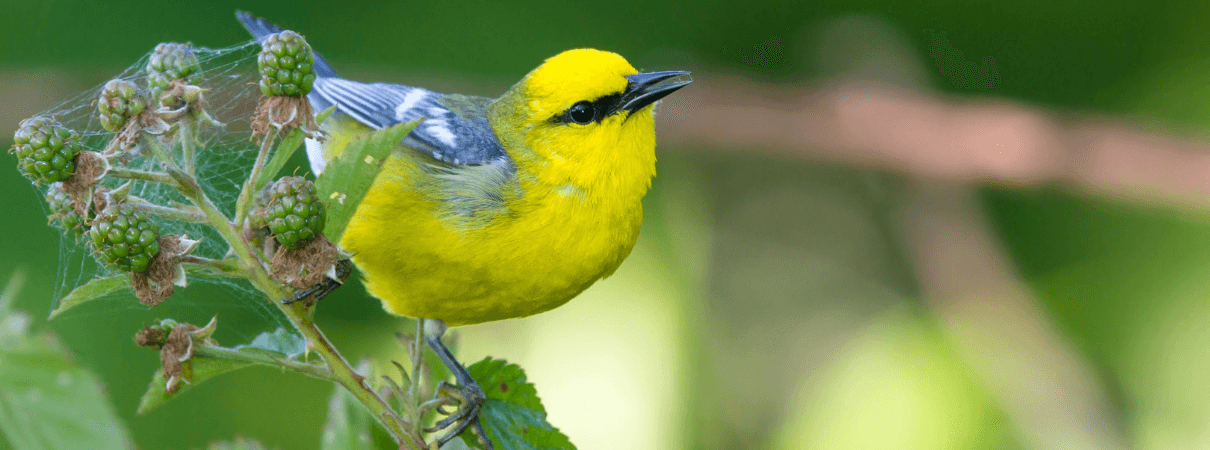New Initiative “Let the Sun Shine In – Indiana” will Work to Restore the State's Oak-Hickory Forests

Blue-winged Warbler by Frode Jacobsen/Shutterstock
(July 5, 2022) Southern Indiana's forests are growing darker, making them more homogenous and emptier of birdlife. Trees like beech and maple have proliferated since humans began suppressing fire in the region, choking out the sunlight that oak trees and other important sources of food and shelter for birds need to thrive. This year, American Bird Conservancy (ABC) has teamed up with more than a dozen public and private partners including The Nature Conservancy, Purdue University Extension, Indiana Department of Natural Resources – Division of Forestry, and US Forest Service to bring back the oaks. The new initiative is called Let the Sun Shine In – Indiana (LSSI – Indiana).
“We are in danger of losing the oak-hickory ecosystem in southern Indiana,” said Kyle Brazil, Central Hardwoods Joint Venture Conservation Delivery Coordinator at ABC. “We need to let the sun shine in, because with sunshine comes life.”
For thousands of years, southern Indiana's landscape was home to vast stretches of open-canopy oak-hickory forests. This was great for the area's birds. Oaks host hundreds of insect species, making them a kind of all-you-can-eat buffet for nesting birds and their hungry chicks. Oaks also have an open canopy that allows light to beam down through the branches. This light fuels a thick understory of grasses, forbs, and shrubs that provide even more food and shelter for nesting and migrating birds. But starting about 100 years ago, humans began to suppress the fires that help oak trees grow.
Without fire, barely any oak trees have reached maturity in that time. Fast-growing but less fire-resistant tree species like beech and maple now dominate the landscape. Unlike oaks, these trees create a dense canopy that blocks most sunlight from reaching the understory. Forests with more beech and maple tend to be less diverse because fewer plants can live in the resulting low-light conditions. That makes these forests a less appealing home to birds like Prairie Warbler, Red-headed Woodpecker, Blue-winged Warbler, and Northern Bobwhite.

A oak-hickory ecosystem landscape by US Forest Service
In southern Indiana, young oaks haven't had the chance to get established for decades. On the current trajectory, once the existing mature oaks and hickories die, other species will replace them.
“Oak-hickory ecosystems in this day and age require active management to persist,” Brazil said. “Without active management, we will lose the oak-hickory ecosystem and the plants and animals it supports.”
LSSI – Indiana will recover and maintain oak-hickory ecosystems using a hands-on approach. Partners will work together to conduct science-based tree harvests to open the canopy. This will let sunshine reach the ground, enabling oak saplings and groundcover to flourish. Then, the team will use carefully applied prescribed fire to enhance and maintain the treatment. The process will take several years.
ABC and other partners will also help educate the public about the importance of active management in these forests. Cutting down trees and using fire can seem like counter-intuitive steps in creating a healthier forest, so demonstration areas will showcase restoration techniques and resulting phases of regeneration.
LSSI – Indiana launches in earnest this fall. If all goes according to plan, southern Indiana forests will – in time – be flooded with life-giving sunlight and a chorus of birdsong once again.
###
American Bird Conservancy is a nonprofit organization dedicated to conserving wild birds and their habitats throughout the Americas. With an emphasis on achieving results and working in partnership, we take on the greatest problems facing birds today, innovating and building on rapid advancements in science to halt extinctions, protect habitats, eliminate threats, and build capacity for bird conservation. Find us on abcbirds.org, Facebook, Instagram, and Twitter (@ABCbirds).
Media Contact: Jordan Rutter, Director of Public Relations| jerutter@abcbirds.org | @JERutter


















































